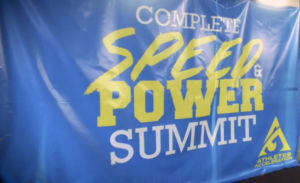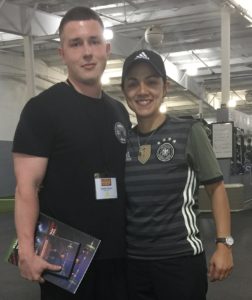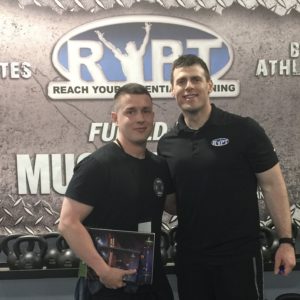
I’ve now been to the Complete Speed and Power Summit twice in less than a year. When I went in September at Reach Your Potential Training in Tinton Falls, NJ, it was just the second time they’ve held the event. I didn’t expect much to change in just nine months, but I managed to leave with a completely different experience than the last time.
Making two trips has given me the chance to see how the event is evolving and growing in popularity. Even though the two-day seminar was solid the first time I went, the people at Athletes Acceleration are always looking for ways to make it better.
That was the message I got after talking to both Pat Beith, the CEO and Founder of Athletes Acceleration, and Alison Culley, the Vice President. Both were very gracious with their time after long day and showed genuine interest in my feedback. Alison talked to me about some things they are looking to do in the future and the passion they have for continuing to make this summit a go-to destination is obvious.

Me with Nicole Rodriguez of Exos.
Athletes Acceleration added some speakers to its lineup and I got to see two different coaches speak this year with Nicole Rodriguez, the performance education manager and performance coach at EXOS and Wil Fleming, the owner of Force Fitness and accomplished weight lifter.
In addition, they changed how they run the hands-on portion, making sure everyone is involved with each group. You’re no longer able to hang out in the back, like I’ve done a couple of times. They make sure you are out there on the floor and it helps you grasp the information a lot better.
They also changed the venue for the social. I wouldn’t have minded hanging out on the beach like last time, but I did interact a lot more at JRs Bar and Grill. There were a lot more coaches at this year’s event and there wasn’t a moment where I wasn’t talking to someone at the social.
One constant between the two visits was the quality of the presentation. Coach Dos, Robert Dos Remedios, kicked us off with programming for power. What I liked about Dos’ presentation is that he discussed how power training isn’t strictly for athletes. This was information I could apply with my general population clients, and he encourages that. He explained how our explosive capabilities decrease as we age and how this type of training helps with strength, balance and is metabolically taxing. Anyone can train for power; it’s all about intent. Whenever I talk to my general population clients about something we are doing from a seminar, I’m usually dropping a few things I learned from Dos.
“Expect the best, plan for the worst and prepare to be surprised.” – Adam Feit
Adam Feit followed with an interesting presentation where he related making cookies with his son

Me with Adam Feit.
to coaching. “Cookie-cutter programs” is a dreaded phrase to coaches, yet Feit said we all have them to a certain extent. The cookie-cutter part is the foundation that all programs need. What separates your program from others is your flair or how you dress up your cookie. That’s where your coaching and the type of system you use comes in. He also discussed having a “triage system” in your system where you address the most serious matters first and “do the best you can with what you have and where you are.” The description doesn’t do the presentation justice. RYPT has a fantastic system and Feit’s presentation was one of the best I’ve heard out of all the seminars I’ve been to because of his style of presenting.
“You need to work through the (speed-strength) continuum and teach the athletes different expressions of force.” – Nicole Rodriguez
Rodriguez gave us an in-depth look inside the EXOS system and ways to go about developing speed and power. She went into putting exercises into three buckets of position, pattern and power and showed us a jump profile relationship with the eccentric utilization ratio (glad to see one of my CSCS words in a presentation). She discussed how to utilize the full speed-strength continuum and went into how the tendons and muscles work during movement. Her hands-on presentation brought everything together and she showed us how to apply the three buckets, along with one of her “money-making” drills.
Dave Gleason closed out the first day with a talk on culture and finding your why. Above any program design, culture is the most important aspect for running a successful facility. He went into all the tiny details your gym should have to create the right culture and creating POMO — the position of maximal opportunity for your athletes. His presentation can be perfectly summed up with this: “when your culture is strong, your athletes will carry the day. They will quickly and effectively homogenize any new athlete into your program.”
“You need to stay in your lane while teaching until you can expand your lane.” – Lee Taft
The knowledge bombs continued on Day Two, starting with the Godfather of Speed, Lee Taft. As someone looking to improve their knowledge of speed, it was interesting to hear and see Lee go through ways he assessed different athletes. The main takeaway was to work with what you know. Lee said you need to assess what you can find answers to and don’t assess what you don’t understand. There are three questions you need to keep in mind while watching your athletes: what did you want to see? Did you see it? Why did you want to see it?
“Why coach away errors when you can program them away.” – Wil Fleming
One presentation that I had starred when I first saw the lineup was Fleming’s talk on Olympic lifting. I’ve made a real effort to try and learn and understand the Olympic lifts and there’s not many people more knowledgable on the subject than him. His presentation delivered more than I expected as he thoroughly broke down the hip, knee and floor position and taught ways to fix various weaknesses. He made it so simple and his DVD on Olympic lifting became an instant buy.

My haul from the weekend.
Finally, the second day concluded with the closer, Bobby Smith. Bobby’s energy is unmatched and he wears his passion for coaching on his sleeve. His energy isn’t the most motivating part of his presentation though. What always strikes a chord with me is when he goes into the story of RYPT and how he saw his vision of building the facility through. On top of that, he’s transparent. He’s not afraid to tell you exactly how they do things at RYPT without holding anything back. Last year he gave his system for developing max velocity, this year he went into their dynamic warmup. He literally lays it all out on the table.
Every time I see him present, I leave with another sheet of exercises and progression of drills I could use with my athletes. My programs are filled with information I’ve learned about the RYPT system. He’s always available to talk and share information. That’s what everyone is like at the Speed and Power Summit. Above all the information you’ll learn from the presentations and hands-on segments, you meet a lot of good people. This is the seminar I feel the most comfortable at because of the people. They make you feel welcome and a part of the team. No matter what else they change and add on in the future, that will always be the best part of the Speed and Power Summit.